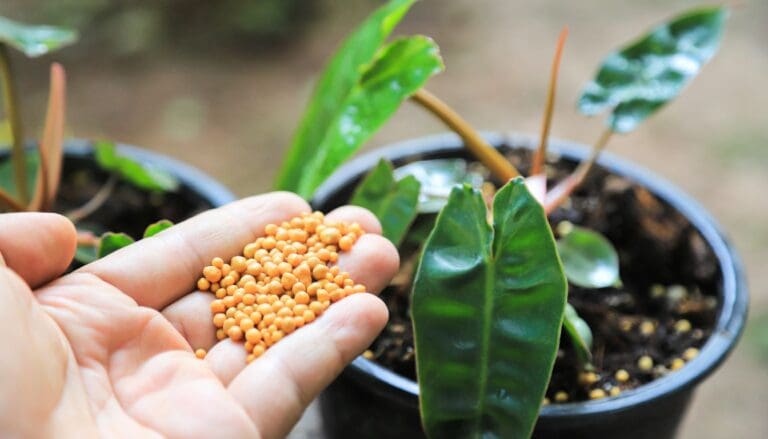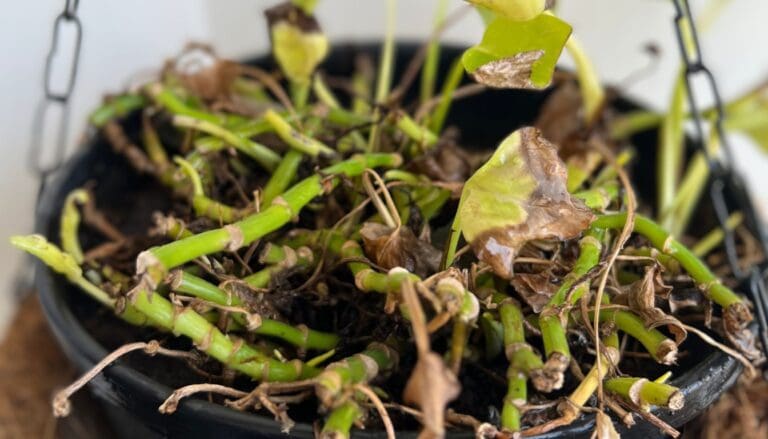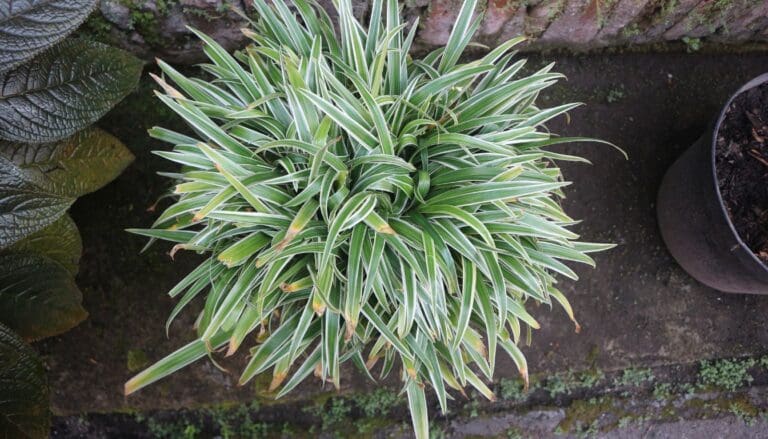7 Reasons Why Your Snake Plant Is Turning Yellow
Snake plants are a great addition to the beauty of any space. But when those shiny green leaves turn yellow, the whole space looks dull and lifeless. A plant owner must understand why their snake plant leaves turn yellow and what they must do to fix the same.
Scorching sunlight, Inadequate watering, and lack of proper ventilation are some essential factors leading to yellow leaves in the snake plant. Apart from these pest infestations, overfertilization, root rot, temperature, and humidity fluctuation can also lead to the yellowing of leaves.
The leaves that are already yellow cannot be fixed, but the issue needs to be rectified, so the remaining and new leaves of your snake plant remain healthy and green. This can be facilitated by following the required steps and knowing the issue concerning yellow leaves.
We have discussed all the problems that lead to the yellowing of leaves in your snake plant. Besides that, preventive measures are given to safeguard your snake plant from yellowing further.

Also read: Why is my snake plant dying?
Please note: Simplify Plants is reader-supported. Some links in the post are affiliate links and I get a commission from purchases made through links in the post.
Why does my snake plant have yellow leaves?
There are several reasons for yellowing a snake plant’s leaves. They shouldn’t be avoided as seasonal factors, as it may to the wilting of your snake plant.
Overexposure to sunlight
Snake plants love to be on the brighter side, but some plant owners place their plants in extreme sunlight. That can cause yellow leaves, sunburn, etc. Light is absorbed by the plant and converted into energy through photosynthesis.
When some planters keep their snake plant near windows, wondering if the plant will get all the light they need, they are going wrong. When keeping near windows, the plant usually gets light more than they need. The glass also magnifies the light intensity.
The snake plant kept near such a spot can be directly affected because of the scorching sun.
The entire plant loses its moisture. The leaves turn yellow and brown, leaving behind a dry plant as the direct sun is still coming on them.
Over Fertilization

Why shouldn’t we keep adding fertilizer to our snake plant? It feels like new plant parents are being stopped to love their plants, but it’s far from reality. In fact, we are trying to help you keep your plants healthy.
Snake plants that can survive on their own are light feeders and shouldn’t be fed excessively to find more return. You will only find leaf burnt or yellow leaves as a return to over-fertilization.
Fertilizers should not be overfed to snake plants as they can concentrate on the soil as salt buildups. They take away the soil’s moisture, which affects the uptake of water and nutrients to other parts of the plant. It results in yellow leaves.
The excess of fertilizers in the snake plant runoff water in the soil and cause algal blooms, which blocks the water flow. When it dies, this algae sits in the water and reduces oxygen in water, affecting the entire functioning of the soil.
Fertilizer contains nutrients that can be categorized as micro and macronutrients. They are essential for any plant to grow and stay healthy. The right kind of fertilizer that is suitable for a snake plant is also important.
Many planters feed all the plants with one fertilizer, which might be right for one plant but not suitable for others. That causes a problem within the plant and then affects the leaf’s health leading to yellow leaves.
Root Rot

Snake plants are sturdy plants, but with too much pressure, they can start suffering. Too much pressure here means several reasons due to which snake plant’s root decay.
- Overwatering frequently
- Poor drainage system
- Heavy potting mix
- Overfertilization
- Contaminated soil
- Fungal or bacterial growth
Snake plants can develop root rot due to the above-given reasons. While overwatering is already affecting roots, soil, leaves of snake plants, due to ignorance, pathogens that are already present in the roots and soil get a favorable environment to grow and attack roots.
The rot takes hold only when they keep getting an appropriate environment. When the planters don’t provide adequate care to their snake plant, the roots’ condition will worsen.
The plant suffers the most when they are continually over watered. They interfere with the water flow, airflow, and nutrients supply into the leaves. The water standing in the soil affects the roots and overall health of the snake plant.
Also read: What type of soil do snake plant need?
Temperature fluctuations
Snake plants comparatively get less affected due to factors that affect other indoor plants easily. That is good news for any hobbyist, especially beginners.
Temperature fluctuations are very stressful for any plant. Snake plants tolerate low to high-temperature levels to a large extent. However, they cannot thrive in very low temperatures for long.
When there is a sudden shift in temperature, whether from low level to high level or vice versa, the snake plant can show signs of stress through yellow leaves.
That doesn’t only involve temperature shifts due to environmental changes but also shifting spots.
Shifting plants from one location to another, keeping near the heating system, or moving indoor-outdoor frequently, even if we do it to help the plant, will affect the plant’s overall health.
Fungal Diseases
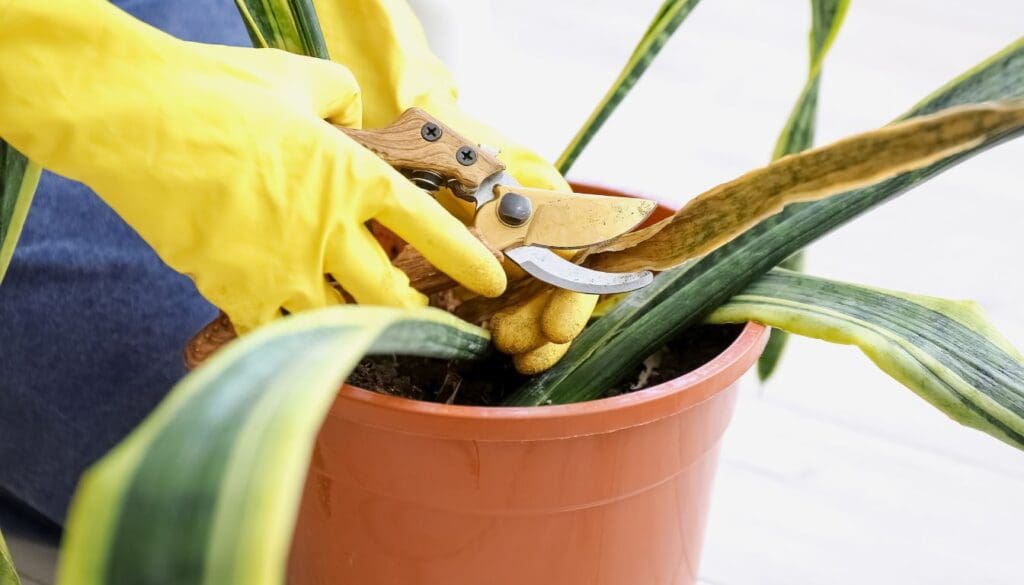
Fungal diseases weaken the plant’s system interrupting photosynthesis and growth. The snake plant that is affected due to fungal disease will have a direct effect on their leaves.
Advancement of fungal diseases is generally due to poor drainage, waterlogged soil, cold weather, and crowded plants. The primary reasons for all fungal diseases are jotted below.
| Diseases | Reasons |
|---|---|
| Fungal leaf spots | –Overwatering especially in winters –Poor light and air –Root decay. |
| Bacterial leaf spots | –High humidity and moisture leaf wetness –Contaminated soil –Poor air circulation –Pathogens growth |
| Powdery mildew | –Formation of mycelium. –Crowded plants –Shady areas –Poorly aerated areas |
| Anthracnose | –Misting too much –Rainy season –Fungi in the genus Colletotrichum –Infected plant debris –Overwatering. |
Inadequate Watering

Inadequate watering can be over watering or under watering your plant. Both are injurious to the snake plant’s health.
Though a snake plant can stay dry for a period that can last a month too, overwatering can damage the snake plant with few sessions only.
Snake plant parents should also understand that keeping their snake plant dry, considering them to be fine in such conditions, is not right. The snake plant will lose its water content in the leaves and soil and lead to yellow leaves.
Snake plants, when overwatered, will give a return in the forms of yellow leaves, curling, root rot, etc. The reason being soil and roots are clogged due to excess water in the soil and roots.
The roots and soil in such conditions will not be able to supply water and nutrients to the leaves; the oxygenation in the soil and roots will be blocked.
That will promote bacterial, fungal growth and pathogen growth, which will damage the roots and soil of the snake plant, making them weak.
Also read: Overwatering vs. Under watering
Pest Infestation
Snake plants can get infected by many pests when kept in unfavorable conditions for too long or get in contact with any other infected plants.
These pests make the snake plant weak and lead to several issues like yellowing, browning, and curling of leaves.
If ignored, it can lead to the plant’s end also. These bugs are a few common ones infecting snake plant:
Aphids: They are small, soft-bodied insects green, yellow, red, black, or brown in color. Adults are usually wingless and are often found feeding on plants in clusters, especially on new growth.
Heavy infestations of aphids may harm the snake plant resulting in yellow, curling leaves.
Thrips: Thrips are active and feed in large groups. They are tiny black slender bugs with wings. They suck juices and scrape fruits, flowers. They suck sap, which has nutrients that turn leaves to yellow and wilt.
Mealybugs: They are Oval-shaped soft-bodied insects covered with wax as a protection layer. Small nymphs are free of wax covering and keep moving until they find a suitable spot to feed on.
Higher pests level will lead to yellowing, curling, and weak plants.
Scales: Looks like small bumps rather than bugs. They are divided into two groups, such as soft and armored.
Soft scales secrete a waxy film and produce honeydew in large amounts.
Armored scales have unattached hard covering and do not secrete honeydew.
Heavy infestations reduce vigor and result in chlorotic leaves.
Also Read: Do Snake Plants Attract Bugs? (+How To Deal With Them)
How to fix yellow leaves on snake plant?
In order to fix yellow leaves on snake plant we need to identify the problem and take appropriate action. Here are some key things to check:
Lighting

The light intensity when coming from the window reduces as compared to the intensity outdoors, so many hobbyists think their plant will get enough light near the window.
The plant might suffer due to too much light from the sun, which can be rectified as soon as you feel it is disturbing your snake plant.
Snake plants like light but not the direct sun, which should be kept in the right direction. To decide the right location for your snake plants goes through the following.
North-facing windows: With weakest and shady light throughout the day. An excellent option for shade-loving plants, but during winters, the plants will hardly receive any light.
South-facing windows: With strong light intensity and receive the most light. Great for sun-loving plants.
East-facing windows: Early sun and very moderate receiving light. Great for plants wanting only moderate or morning sun.
West-facing windows: Receive afternoon and evening sun, which is strong in summer. Great for sun-loving plants.
You can keep your snake plant 6-8 feet away from the east, west, or south-facing window. If you plan to keep them on the window sill, then go for a north-facing window.
Also read: How much light do snake plant need?
Fertilization

Fertilization is essential to keep your snake plant healthy but should be monitored when and how to fertilize. Fertilizers are essential because:
- Provide needed nutrients to the plants.
- Improve the fertility and texture of the soil.
- It helps in adding lost nutrients.
Fertilize snake plant with all-purpose houseplant fertilizer(10:10:10) during summers. While fertilizing, dilute the recommended dosage with water for even distribution in the soil.
Fertilize once every 1-2 months and not more than that. Do not fertilize during winter as it is a dormant period for plants and will harm the plant more rather than helping them.
Also read: Do snake plant need fertilization?(How much and how often)
Root rot

Root rot treatment depends on the extent of the rot.
If the rot is mild, simply wash the plant with water and some dish wash soap. Keep the plant in the sun till the soil gets dry completely.
Prune off any damaged leaves and spray any organic insecticides on the plant once a week.
If the rot is severe, start by trimming off the damaged leaves and wash the plant thoroughly. Take the plant out of the pot and remove all mushy, weak roots with sterilized sheers.
For the snake plant’s speedy recovery and formation of new roots, it is essential to treat rapidly and replant.
You can treat using any of the following to limit the disease progression:
- FungicidesChloropicrin
- Methyl bromide
- Neem oil
- Horticulture oil
- Cinnamon powder
Root rot can spread to other parts of the plant affected and will become very hard to be treated or revive back. Plant the snake plant with fresh, sterilized, well-aerated soil. Let the plant breathe and ensure a proper drainage system.
Also Read: Root Rot In Snake Plant? (Signs, Causes & Fix)
Temperature

Temperature fluctuations are cultural, which you cannot sop, but you can bend them. The snake plant favors a warmer temperature level between 55 degrees Fahrenheit to 85 degrees Fahrenheit to thrive the most.
If the temperature level fluctuates, you need to make sure that your plant is getting ideal or in as much favorable condition as you can.
During cold weather, keep your snake plant indoors to protect them from cold drafts. Keep a few feet away from heating systems to increase temperature levels but, at the same time, avoid direct airflow.
Also read: Where should I keep my snake plant? (Best spot+Tips)
Fungal Diseases
Move the sick plant to a place where no other plant is around. Start with pruning damaged leaves.
Wash the plant thoroughly and pick any damaged leaves with hands. Now take the following steps further to treat the infected plant.
- Take 1 cup of hot tap water into a plastic spray bottle and add 1 1/2 teaspoons of baking soda. Shake the bottle to dissolve the baking soda.
- Add 1 ½ tsp fungicide to the spray bottle and shake well.
- Wash the plant and spray the mixture on the foliage.
- Stalks and undersides of the leaf should be taken extra care of as they are often overlooked.
- Treat the snake plant every 5 to 7 days after that throughout the growing season, even if the problem is resolved.
Give the plant as much indirect light as you can and keep in warm temperature levels.
Do not water for a few days. Make sure the drainage system is proper and never over water a snake plant.
Inadequate Watering

Moderation and consistency are crucial while watering your snake plant. Modify your watering routines and water when the snake plant needs it.
Check the soil moisture by digging your finger or skewer from the top of the soil up to a few inches in the soil.
If, after pulling out the finger/skewer from the soil is stuck to it, then the soil is moist from within.
Let the soil dry and keep looking when the soil needs water.
Waterlogged snake plants may even die, so you can keep your snake plant dry for some more time but cannot stay wet consistently.
Make sure to give them proper light and water when you see the soil is dry.
Pests
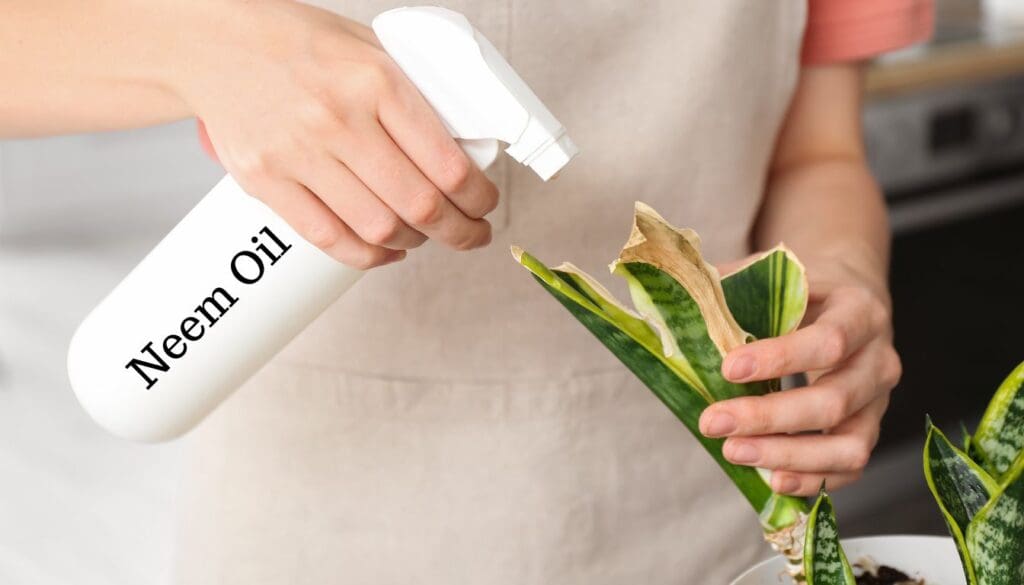
Treat the pests infested plant in the following ways:
- Prune damaged leaves of infested leaves, stems, and or other parts and discard them in the trash. Isolate the plant to stop spreading the infestation to other plants.
- Wash the plant with running water to get rid of pets.
- Use neem oil and apply it once every week to kill bugs eggs and interfere with the life cycle of the pests. Cover all parts of the snake plant and apply it in the evening.
- Insecticidal soap or biological insecticides are also a great option to treat heavy infestations, especially when coming in contact with pests.
- Use the least toxic pesticide for severe infestations and to prevent bugs population explosions and provide protection in the future from pests.
- Now keep the plant in indirect sun and do not overwater it or water only when the soil is dry. Keep the leaves clean and dry. Keep the plant at moderate temperature levels to avoid attracting pests.
How do you save yellowing snake plant?
Snake plants are not very needy, and simple routines can keep them thriving and prevent yellow leaves.
- Monitor the light, water, and air circulation available for and around the plant. With indirect light, water when dry soil, and plenty of ventilation, the snake plant will remain healthy.
- Check the climate conditions as the plant will need more light and less water during cold weather. Irrespective of the conditions, make sure the pot has a proper drainage system.
- Soil pH level needs to be between 6.1- 6.5. The soil mix should be nutrition-rich and well aerated.
- Fertilize once every 1-2 months with all-purpose houseplant fertilizer by diluting.
- Keep inspecting your snake plants’ health and needs. That will give you regular details of any requirement, and any changes can be immediately identified and resolved.
- Clean the leaves regularly to avoid attracting pests and other leaf related issues. Misting is preferred to be avoided in the case of a snake plant.
- Horticulture oil spray can be used as a preventive measure for avoiding yellow leaves and pests attack.
Also read: 9 Tips to grow your houseplant faster

Related questions
Should I remove yellow leaves from the snake plant?
Yes, prune all yellow leaves from the snake plant as they are of no use. The pruning of leaves will boost the growth of plants as the plant can focus its energy on new growth.
Can yellow leaves turn green again?
No, yellow leaves cannot turn green again, unfortunately. But to make sure the new leaves grow healthy and green, you need to take care and rectify the issue.
Source: The University of Arkansas Division of Agriculture, University of Minnesota, Snake plant profile, Lighting Indoor Houseplants
Recommended Garden Supplies
| Product Image | Our Recommended Gardening Supplies | Check Offers! |
|---|---|---|
Top Top
Top
Top
Top
Top
Top
Top
Top | rePotme Houseplant and Tropical Classic Potting Soil Mix | Check Offer On Amazon |
 Top
Top
Top
Top
Top
Top
Top
Top | Espoma Organic Indoor Plant Food | Check Offer On Amazon |
 Top
Top
Top
Top
Top
Top
Top
Top | GooingTop LED Grow Light 6000K Full Spectrum Clip Plant Growing Lamp | Check Offer On Amazon |
 Top
Top
Top
Top
Top
Top
Top
Top | Soil Moisture Meter | Check Offer On Amazon |
 Top
Top
Top
Top
Top
Top
Top
Top | Govee Hygrometer Thermometer, Bluetooth Enabled! | Check Offer On Amazon |
 Top
Top | LEVOIT Humidifiers for Large Room(Best For Plants) | Check Offer On Amazon |
 Top
Top
Top
Top
Top
Top
Top
Top | Upgraded DIY Automatic Drip Irrigation Kit, 15 Potted Houseplants Support | Check Offer On Amazon |
 Top
Top
Top
Top
Top
Top
Top
Top | Stainless Steel Heavy Duty Gardening Tool Set | Check Offer On Amazon |
 Top
Top
Top
Top
Top
Top
Top
Top | Bonide Insecticidal Soap | Check Offer On Amazon |
 Top
Top
Top
Top
Top
Top
Top
Top | Bonide 32 oz Spray Neem Oil for Organic Gardening | Check Offer On Amazon |
 Top
Top
Top
Top
Top
Top
Top
Top | Garden Safe Fungicide | Check Offer On Amazon |


